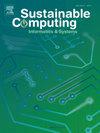Point cloud recognition of street tree canopies in urban Internet of Things based on laser reflection intensity
IF 5.7
3区 计算机科学
Q1 COMPUTER SCIENCE, HARDWARE & ARCHITECTURE
引用次数: 0
Abstract
Light Detection and Ranging (LiDAR) technology, as a core component of the IoT perception layer, has become a research focus for street tree canopy target recognition. However, traditional methods relying on point cloud geometric features often struggle to achieve accurate identification in complex scenarios where tree canopies intertwine with adjacent objects. To address this issue, this study proposes a novel point cloud recognition method based on laser reflection intensity. First, a 2D LiDAR combined with Mobile Laser Scanning (MLS) technology was employed to collect training datasets (distance-intensity and incidence angle-intensity) for constructing an intensity correction model. Subsequently, urban street point cloud intensity data were acquired using a 2D LiDAR-based MLS system, followed by distance and incidence angle correction. Finally, the intensity threshold for canopy recognition was determined based on the probability density distribution of the corrected intensity data. To validate the method’s effectiveness, the intensity threshold calibrated from a 40-meter road segment was applied to another 80-meter segment within the same street scene. The performance of the original and corrected intensity thresholds was then compared. Experimental results demonstrated that the corrected intensity threshold achieved an F1-score of 0.84 for canopy point cloud recognition, representing a 31 % improvement over the original threshold (F1-score: 0.64). This confirms that the proposed method significantly enhances recognition accuracy in complex urban environments.
基于激光反射强度的城市物联网街道树冠点云识别
光探测与测距(LiDAR)技术作为物联网感知层的核心组成部分,已成为街道树冠目标识别的研究热点。然而,传统的基于点云几何特征的方法往往难以在树冠与相邻物体交织的复杂场景中实现准确的识别。针对这一问题,本研究提出了一种基于激光反射强度的点云识别方法。首先,利用二维激光雷达结合移动激光扫描(MLS)技术采集训练数据集(距离-强度和入射角-强度),构建强度校正模型;随后,利用基于2D lidar的MLS系统获取城市街道点云强度数据,并进行距离和入射角校正。最后,根据校正后的强度数据的概率密度分布确定冠层识别的强度阈值。为了验证该方法的有效性,将40米道路段校准的强度阈值应用于同一街景中的另一个80米路段。然后比较原始和校正后的强度阈值的性能。实验结果表明,校正后的强度阈值对冠层点云识别的f1得分为0.84,比原始阈值(f1得分为0.64)提高了31% %。这证实了该方法显著提高了复杂城市环境下的识别精度。
本文章由计算机程序翻译,如有差异,请以英文原文为准。
求助全文
约1分钟内获得全文
求助全文
来源期刊

Sustainable Computing-Informatics & Systems
COMPUTER SCIENCE, HARDWARE & ARCHITECTUREC-COMPUTER SCIENCE, INFORMATION SYSTEMS
CiteScore
10.70
自引率
4.40%
发文量
142
期刊介绍:
Sustainable computing is a rapidly expanding research area spanning the fields of computer science and engineering, electrical engineering as well as other engineering disciplines. The aim of Sustainable Computing: Informatics and Systems (SUSCOM) is to publish the myriad research findings related to energy-aware and thermal-aware management of computing resource. Equally important is a spectrum of related research issues such as applications of computing that can have ecological and societal impacts. SUSCOM publishes original and timely research papers and survey articles in current areas of power, energy, temperature, and environment related research areas of current importance to readers. SUSCOM has an editorial board comprising prominent researchers from around the world and selects competitively evaluated peer-reviewed papers.
 求助内容:
求助内容: 应助结果提醒方式:
应助结果提醒方式:


